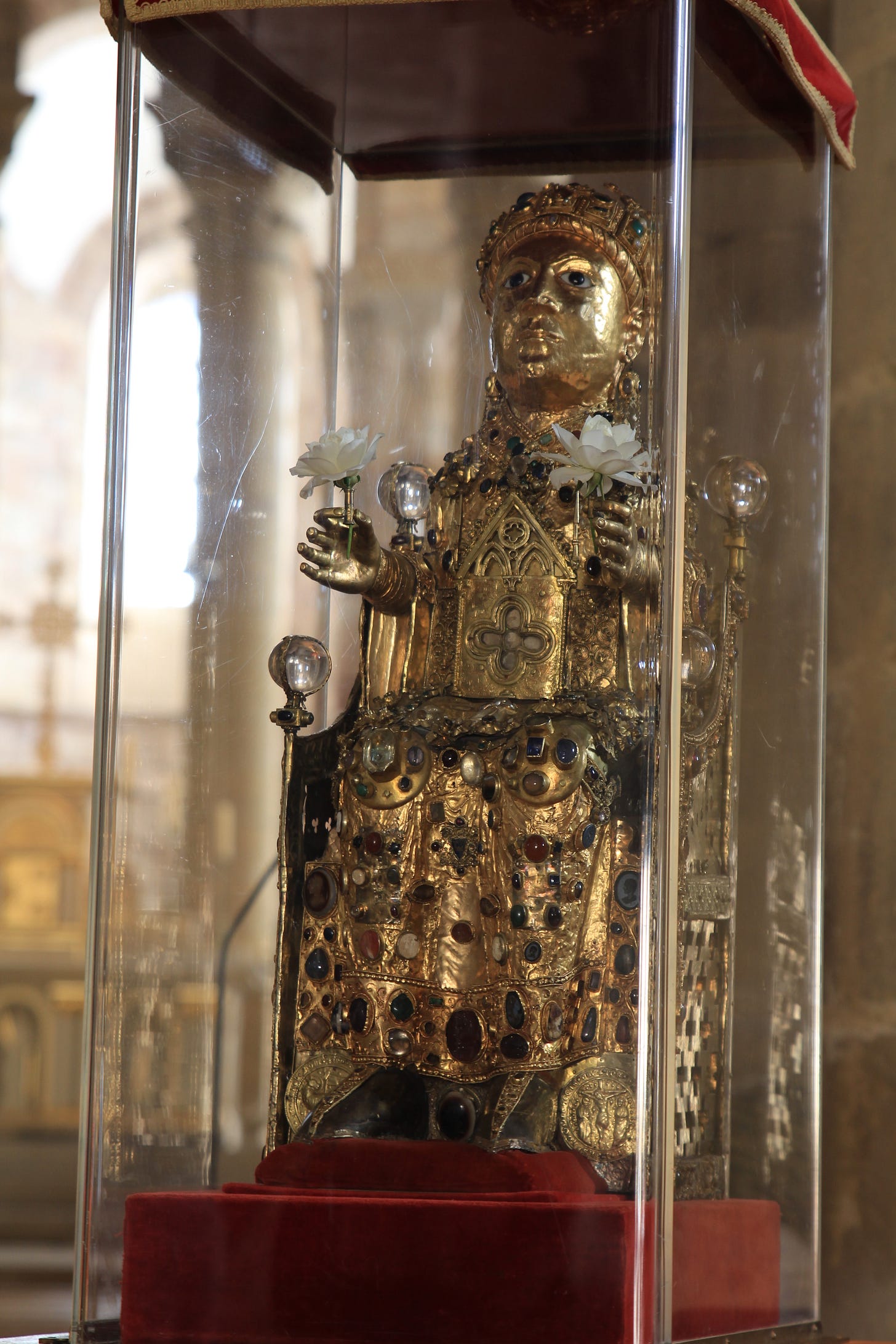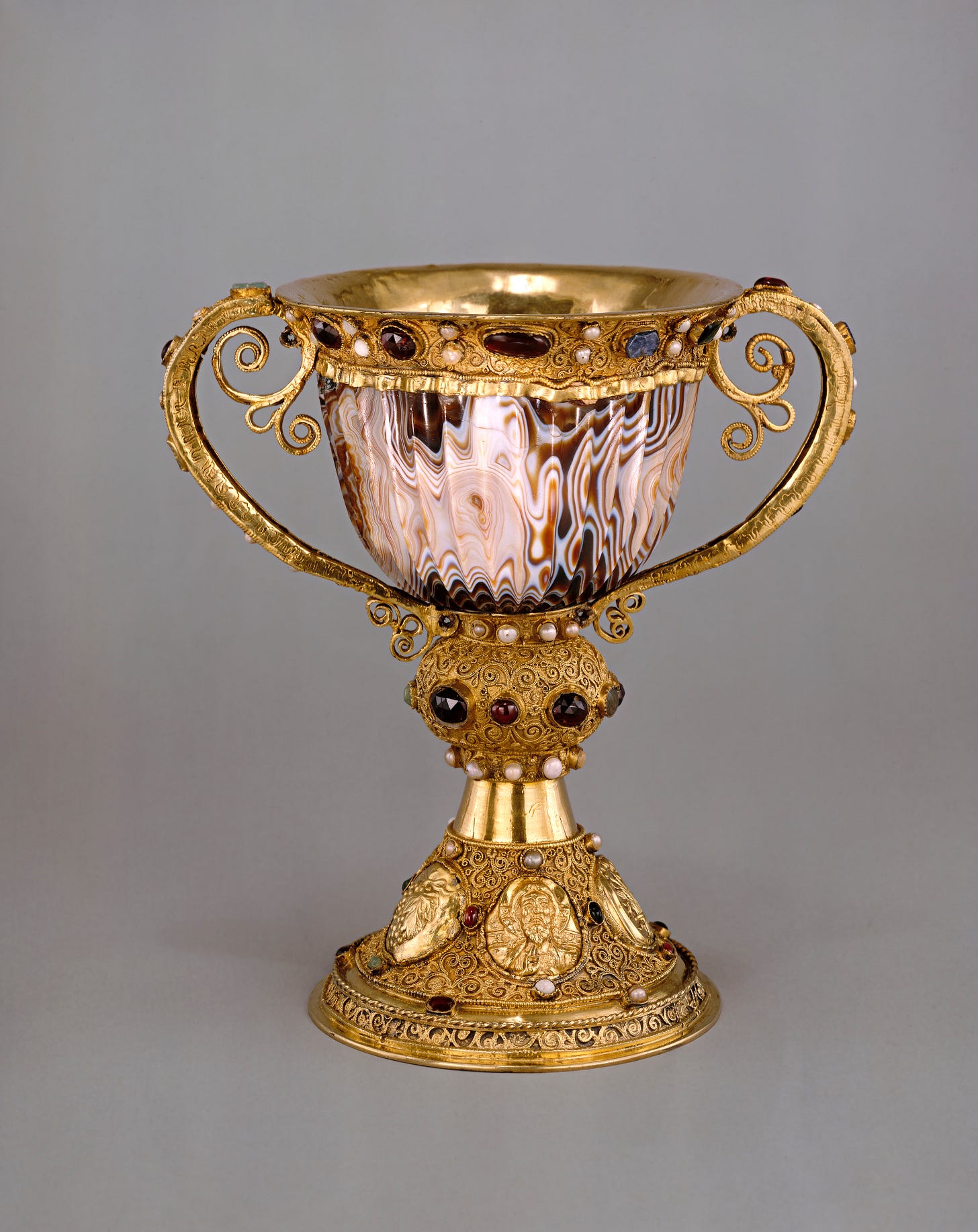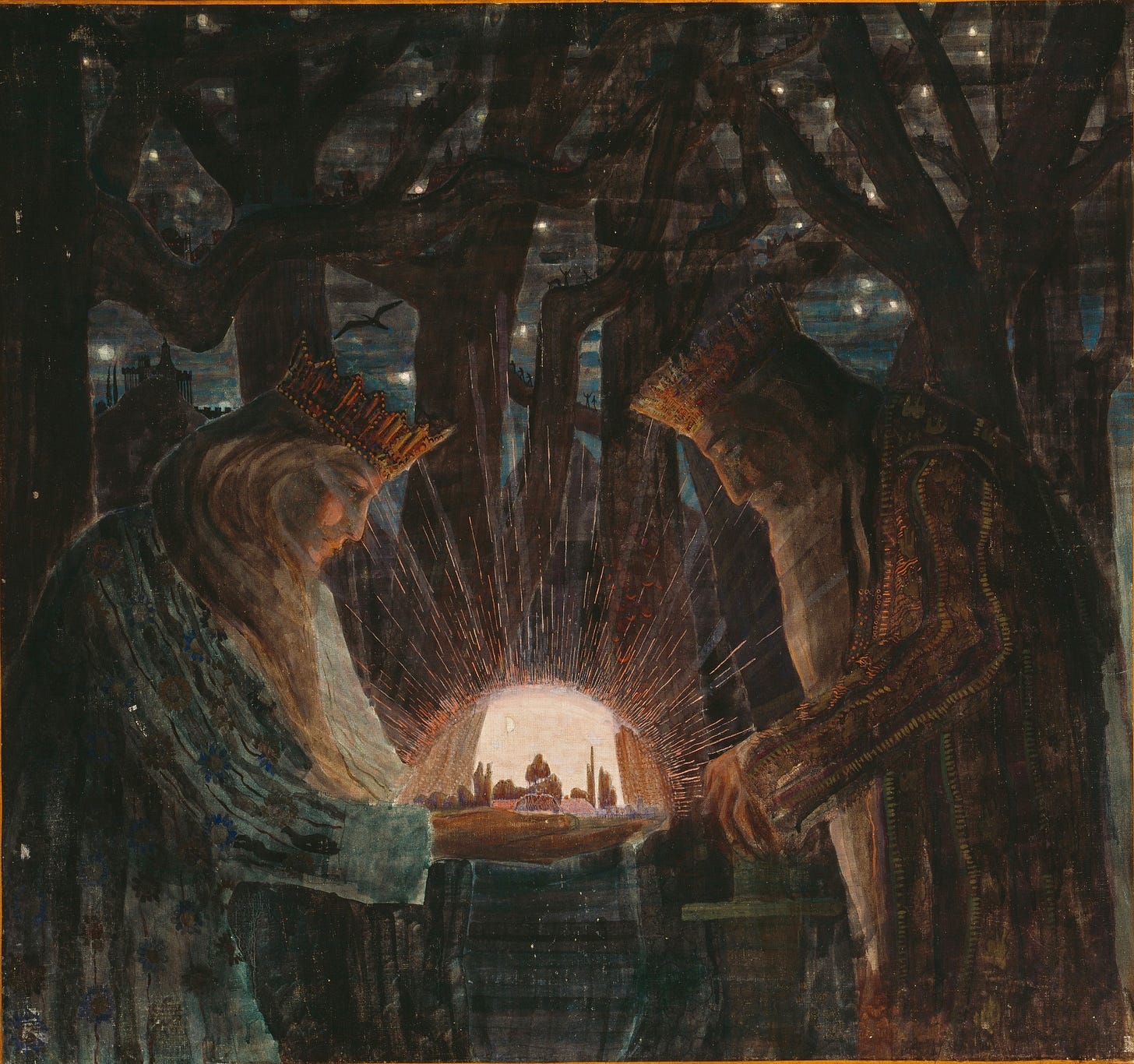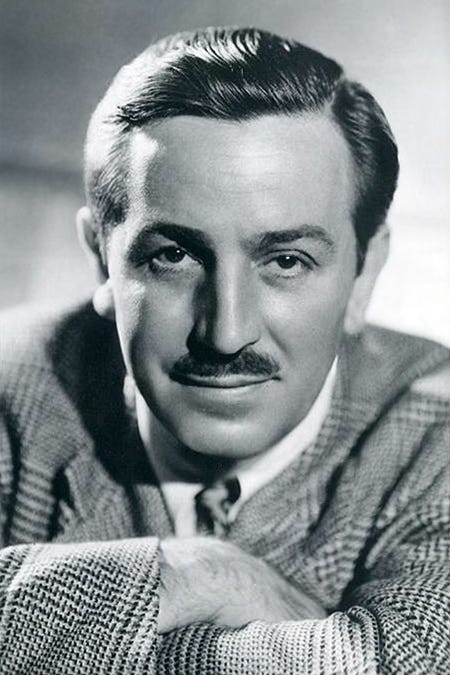Walt Disney VS Humanity
Lewis and Tolkien on myth, story, and the primitive chords of the heart
Imagine that you are having an oat milk chai latte with your friend. After the small talk comes to an end, she pauses, smiles, and says: “Well, I have something to tell you!”
“Yes?”
“I’ve decided that I’m going to become…a novelist!”
“Oh! Wow! That’s great,” you say, a little surprised. “Well, tell me about your first book…”
“Well,” she says, “it’s set in Iowa, and it involves a middle-class family with a bunch of daughters. Their busybody mother is desperate to get them married off, and so, when a wealthy planter moves into the area, she’s excited about the prospect. They invite this Mr. Baker over for dinner, but when he comes, he brings his best friend, a Mr. Garby. This friend is reportedly twice as rich as Mr. Baker, but he’s super haughty and he snubs Eliza, the second-oldest daughter. But, in the end, he falls in love with her, and they get married. What do you think?”
“Hmmm...”
How would you reply to your friend about her Iowa-based novel? In all likelihood you would, politely, say:
“Um, that’s sort of been written before, hasn’t it?”
The point behind my thought experiment is this: in the modern age, we often implicitly judge a work of art as good if it is innovative, original, new, or says something that’s never been said before. But if it clings too closely to a previously existing work, we say, “Meh, it’s okay, but it’s kind of derivative.”
But for our medieval ancestors, things were different. A poet who repeated a story wasn’t considered a bad poet just because he wasn’t original; rather, it seems almost as if medieval authors valued stories in a similar way to how medieval jewelers and goldsmiths valued gems. Precious gems from antiquity were often taken and put into new settings. Unlike us, they did not try to preserve ancient things through meticulous conservation, putting them behind glass in a museum, as untouched and perfectly preserved archaeological objects. Rather, medieval artists—and storytellers—were interested in use and reuse. Take, as an example, the many reliquary cases, which were made by recycling old materials. The reliquary case of Ste. Foy, in France, was a casing made for the wonder-working remains of an obscure, early Christian martyr, but it was made by recycling old gems, and even, it seems, an ancient Roman death mask.

But pilgrims would bring new gems and give them to the abbey, as votive offerings, and then these gems would be added to the reliquary container. Aesthetic recycling.
Or, consider, Suger’s chalice, which sets an ancient sardonyx cup into a new gold frame:

The important thing was to preserve the precious object by giving it new life, giving it a new function, putting it into a new setting.
In a similar way, medieval architects would go to Rome or Constantinople and literally remove pieces of marble, columns, doors, or steps: these were called spolia. Having laboriously transferred these precious building materials back up to the cold north, they would weave the spolia into their own monuments back home.
And in a way similar to the spolia of ancient columns or ancient gems, even medieval melodies, such as that of the song, “l’homme armé,” could be woven into a mass setting, slowed down and expanded, as Josquin des Prez did for it.
All this helps us better understand medieval literature in general. It was okay to mingle new elements with old, and to reset ancient spolia. It wasn’t considered a defect for Chaucer to borrow from Bocaccio, or Malory to borrow from earlier Arthurian Romances, and then set all of these stories in a new frame. What was important, was that the old stories were preserved: and thus, the old stories were translated, turned into verse, amplified, reworked, combined, recycled, and even “up-cycled.” Sometimes a medieval poet would get hold of a manuscript that had commentary in the margins, and when doing his “translation,” he would even incorporate these later glosses into the main text of his translation. It was now a value-added poem.
In any case, this is what Lewis called “traditional poetry.” Once we are “clear,” he said, “that Layamon is not the author of the Brut, nor Johan of Sawles Worde, in the sense in which Jane Austen is the author of Persuasion,” then we can come to appreciate the slow process of accretion and accumulation, the composition of the ages, “a process which is quite foreign to modern literature” which looks for “originality.” These “traditional” poets seem strikingly strange to us, because they at once “seem enslaved to their originals” but in another very “cavalier.” They would never hesitate to “supplement them from their own knowledge and, still more, from their own imagination—touching them up, bringing them more fully to life” (“The Genesis of a Medieval Book,” in Stud. in Med. Lit., 36–37). In another passage worth quoting in full, Lewis likened the medieval compositional practice to painters who add new colors to an old panel:
[W]e might equally well call our medieval authors the most unoriginal or the most original of men. They are so unoriginal that they hardly ever attempt to write anything unless someone has written it before. They are so rebelliously and insistently original that they can hardly reproduce a page of any older work without transforming it by their own intensely visual and emotional imagination, turning the abstract into the concrete, quickening the static into turbulent movement, flooding whatever was colorless with scarlet and gold.
They can no more leave their originals intact that we can leave our own earlier drafts intact when we fair-copy them. We always tinker and (as we hope) improve. But in the Middle Ages you did that as cheerfully to other people’s work as to your own. (“The Genesis of a Medieval Book,” Stud. in Med. Lit., 38)
All of this, so far, is of historical interest. It helps us understand the medieval mind and those often strange medieval texts. But Lewis (and Tolkien) seemingly had a secret, psychological interest in such stories. Both Lewis and Tolkien seemed to have thought that these stories, somehow, someway, long ago, in the deep abyss of time, captured in a linguistic “net” some elusive and fugitive spiritual quality. These stories were almost discovered by accident, like some scientific principle. But, once discovered, you could plainly observe that some stories were so perfect that they could move you, even if they were not masterfully told, just like there are some chords that, even when not worked out into a proper composition, you can feel in the heart. And then these stories, like linguistic spolia dug up long ago out of the abyss of the psyche, were able to be transported and reincorporated into new contexts, like gems reset upon a reliquary case.
Lewis’s name for such stories—a name he does not particularly like—was “myths.” He didn’t like the name because he thought that most stories from ancient mythology are cruel and senselessly violent and, he says, sometimes simply stupid, and yet, and yet, “out of this rank and squalid undergrowth the great myths—Orpheus, Demeter and Persephone, the Hesperides, Balder, Ragnarok, or Ilmarinen’s forging of the Sampo—rise like elms.” These myths, he elegantly says, always have simple shapes (like a Greek vase or a tulip). In fact, they are sometimes so simple that they don’t even need a plot or require a well-developed character. Sometimes all you needed was just a setting!
“The pleasure of myth depends hardly at all on such usual narrative attractions as suspense or surprise. Even at a first hearing it is felt to be inevitable. And the first hearing is chiefly valuable in introducing us to a permanent object of contemplation more like a thing than a narration—which works upon us by its peculiar flavour or quality, rather as a smell or a chord does. Sometimes, even from the first, there is hardly any narrative element. The idea that the gods, and all good men, live under the shadow of Ragnarok is hardly a story. The Hesperides, with their apple-tree and dragon, are already a potent myth, without bringing in Herakles to steal the apples.” (Experiment in Criticism, 43)
These stories feel like they come from another world: “Human sympathy is at a minimum. We do not project ourselves at all strongly into the characters. They are like shapes moving in another world. We feel indeed that the pattern of their movements has a profound relevance to our own life, but we do not imaginatively transport ourselves into theirs” (Experiment in Criticism, 43). And what do they feel like? “The experience is not only grave but awe inspiring. We feel it to be numinous. It is as if something of great moment had been communicated to us. The recurrent efforts of the mind to grasp—we mean, chiefly, to conceptualise—this something, are seen in the persistent tendency of humanity to provide myths with allegorical explanations. And after all allegories have been tried, the myth itself continues to feel more important than they” (Experiment in Criticism, 43).
You could think of such “myths” (and Tolkien seems to be thinking of the same thing when he uses his imperfect term, “fairy story”) as pearls, long in the making of the belly of a oyster that has swallowed a grain of dirty sand, or, alternatively, as one of your grandmother’s ornaments, too beautiful to sell or give away. There is something not just “old” about them, but ageless. Tolkien says they give a “satisfaction of certain primordial human desires. One of these desires is to survey the depths of time and space” (“On Fairy-Stories,” 44). In this way, fairy tales and myths have always been old: even in antiquity they were already ancient! As Tolkien enigmatically put it, these myths have a “remoteness” even “older” than antiquity. Fairy stories, Tolkien said, “are now old, and antiquity has an appeal in itself. ... and yet always the chief flavor of [these tales] in the memory [is] ... distance and a great abyss of time, not measurable even by twe tusend Johr... [They] open a door on Other Time, and if we pass through, though only for a moment, we stand outside our own time, outside Time itself, maybe” (“On Fairy-Stories,” 44). This sense of great age is related to their “numinous” or “perilous” quality. Fairy stories are fay. Because these myths possess the quality of the “fay”—the eerie, the “numinous”—they make up a special spiritual inheritance of humanity. They should be protected by UNESCO.
If Lewis sometimes sounds like a snob—and he does at the beginning of Experiment in Criticism: my students are offended by it!—it’s because he thinks that almost all of the art we look it, almost all the music we listen to, and almost all the things we read are deprived of these elements of depth. We’ve lost access to our human inheritance. Lewis really seems to believe that most of us spend most of our lives without any real encounter with such depth. We read for self-improvement, entertainment, to keep up with current events, but most of what we consume is as empty caloried as most of what we eat. Our stories have had the mythic removed; a drum kit has replaced the plucking of the primitive chords of the human heart, those psychologically elemental components of the soul discovered and excavated in the deep abyss of time.
Do you agree?
Now here’s the fun part: Walt Disney shouldn’t have been allowed to turn them into movies, just as real estate developers ought not to be allowed to turn Gettysburg or George Washinton’s estate into a shopping center.
Imagine a fairy story, like the one Tolkien himself mentions in his famous essay: “The Goose Girl.” If Walt Disney had got a hold of that one, he would have given more personality to the princess, probably would have made the king a little old man with kindly intentions. The chamber maid would have become sassy and self-assertive, and Disney certainly wouldn’t have missed the opportunity to feature a talking horse. He would have certainly downplayed the chambermaid’s shocking punishment, and, by doing so, also downplayed the deep sense of cosmic injustice. It would have pulled the story from the “perilous realm” into the realm of Event and Personality. If Walt Disney got a hold of it, it would have looked like this. Or this. Not, like this:

In other words, Walt Disney de-mythologizes myth. And that is why the scholar, Jack Zipes, has devoted his life to the de-Disneyfication of fairy tales.
Zipes believes that Walt Disney’s chief offense was the commodification of the fairy tale: that is, in a capitalist market you have to have a product that outperforms every other product. Walt Disney wanted to bury his competition—the traditional, community-based tale—and so he injected personality and action and speed and technology into the old story, so that his name would become synonymous with the fairy tale. This is not “traditional poetry.” This is building an interstate on top of what used to be historic farmland.
Here is Jack Zipes’s fascinating critique:
[T]he voice in fairy-tale films is at first effaced so that the image totally dominates the screen, and the words or narrative voice can only speak through the designs of the animator who, in the case of Walt Disney, has signed his name prominently on the screen. In fact, for a long time, Disney did not give credit to the artists and technicians who worked on his films. These images were intended both to smash the aura of heritage and to celebrate the ingenuity, inventiveness, and genius of the animator. In most of the early animated films, there were few original plots, and the story-lines did not count. Most important were the gags, or the technical inventions of the animators ranging from the introduction of live actors to interact with cartoon characters, to improving the movement of the characters so that they did not shimmer, to devising ludicrous and preposterous scenes for the sake of spectacle. It did not matter what story was projected just as long as the images astounded the audience, captured its imagination for a short period of time, and left the people laughing or staring in wonderment. The purpose of the early animated films was to make audiences awestruck and to celebrate the magical talents of the animator as demigod. As a result, the fairy tale as story was a vehicle for animators to express their artistic talents and develop their technology. The animators sought to impress audiences with their abilities to use pictures in such a way that they would forget the earlier fairy tales and remember the images that they, the new artists, were creating for them. Through these moving pictures, the animators appropriated literary and oral fairy tales to subsume the word, to have the final word, often through image and book, for Disney began publishing books during the 1930’s to complement his films. (“Breaking the Disney Spell,” in The Classic Fairy Tales: A Norton Critical Edition)
Is Zipes right? We can do a quick test: I’ll give you a couple of fairy tales and you think what images first come into mind: “Cinderella”; “Beauty and the Beast”; “Snow White”; “Little Mermaid.” Many of us have not read the originals, and even those of us who have, have a hard time reaching back into them after our imaginations have been nearly electrocuted to death by watching Walt Disney’s versions. Disney, according to Zipes, wanted a monopoly on the old stories, wanted to take our spiritual inheritance and turn it into a money-making tool ( = commodification). Indeed, Disney has been the driving force in copyright extension. In the so-called, Mickey Mouse Protection Act of 1998, the copyright periods were dramatically extended. Disney wants to own fairy tales, exclusively and forever.
So, yeah, Lewis and Tolkien have the right be a little grumpy.





Did you know that Lewis and Tolkien went to the movie theater together to watch the original 1937 first full length animated film “Snow White and the Seven Dwarfs”? I had a teacher tell me this story. Tolkien went off about the dwarfs afterwards. It’s all wrong. They are not comic relief! They are The Church! They are Gimli!
All Lewis said about the movie was “It was a great technical achievement”.
I can picture Lewis walking into a movie theater complete with popcorn, drinks, and a Good and Plenty box. Tolkien is walking behind, very stoic and silent.